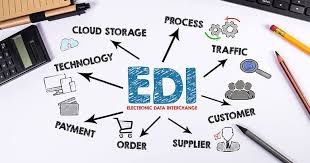What is Electronic Data Interchange (EDI)?

Electronic Data Interchange (EDI) is the structured transmission of business documents between organizations in a standardized electronic format. It automates the exchange of information, replacing traditional paper-based documents such as purchase orders, invoices, shipping notices, and payment details. By using EDI, businesses can improve operational efficiency, reduce costs, and eliminate manual errors in data handling.
Understanding EDI
EDI involves the use of standardized formats to exchange data between two or more trading partners. It enables the seamless flow of information from one computer system to another without human intervention. This ensures that data integrity is maintained and business processes are accelerated.
Key Components of EDI
-
Sender and Receiver: Two parties involved in exchanging data electronically.
-
EDI Standards: Defines the format and structure of the documents exchanged.
-
Translation Software: Converts business documents into EDI formats and vice versa.
-
Communication Protocols: Ensures secure and reliable data transmission between systems.
How Does EDI Work?
The EDI process follows a series of well-defined steps:
-
Document Creation: The sender's internal system generates a business document such as an invoice or purchase order.
-
Data Conversion: The document is converted into a standard EDI format (e.g., ANSI X12, EDIFACT, or XML) using EDI translation software.
-
Transmission: The EDI file is transmitted to the recipient through secure communication protocols such as AS2, FTP, or VAN (Value-Added Network).
-
Data Reception and Translation: The receiver’s system interprets and converts the EDI document back into a readable format.
-
Processing and Integration: The received data is integrated into the recipient’s internal system for further action.
Common EDI Document Types
-
Purchase Orders (PO): Placed by the buyer to request goods or services.
-
Invoices (IN): Sent by the seller to request payment.
-
Advanced Shipping Notices (ASN): Provides shipment information before delivery.
-
Payment Instructions (PI): Details on how payments will be processed.
EDI Standards and Protocols
EDI follows global standards to ensure consistency and compatibility between trading partners. The most widely used standards include:
-
ANSI X12 (American National Standards Institute): Common in North America.
-
EDIFACT (Electronic Data Interchange for Administration, Commerce, and Transport): Popular in Europe and Asia.
-
TRADACOMS: Used primarily in the UK retail sector.
-
XML (Extensible Markup Language): A modern alternative for data exchange.
Benefits of EDI
1. Increased Efficiency
EDI automates the exchange of business documents, reducing manual intervention and accelerating business processes.
2. Cost Savings
Eliminating paper-based transactions and reducing administrative efforts lowers operational costs.
3. Improved Accuracy
Since EDI eliminates manual data entry, the chances of errors are significantly reduced.
4. Faster Transactions
Data is transmitted and processed almost instantly, leading to faster order fulfillment and payment cycles.
5. Better Business Relationships
Consistent, reliable communication between trading partners strengthens relationships and ensures smooth operations.
Applications of EDI Across Industries
-
Retail: Automates order processing, inventory management, and invoicing.
-
Healthcare: Facilitates the secure exchange of patient records, insurance claims, and payments.
-
Manufacturing: Enhances supply chain management and procurement processes.
-
Logistics and Shipping: Improves order tracking, shipment notices, and delivery confirmations.
-
Finance: Streamlines electronic payments and account reconciliations.
Challenges of EDI Implementation
-
Initial Setup Costs: Implementing EDI infrastructure requires an upfront investment.
-
Complex Integration: Integrating EDI with existing enterprise systems can be challenging.
-
Partner Onboarding: Ensuring all trading partners comply with the same EDI standards takes time and effort.
Future of EDI
As technology evolves, EDI is becoming more integrated with cloud platforms, blockchain, and Artificial Intelligence (AI) to offer greater security, scalability, and flexibility. EDI’s future will focus on real-time data exchange and enhanced automation for seamless business operations.
Conclusion
Electronic Data Interchange (EDI) is a transformative technology that simplifies and accelerates business communication by replacing manual, paper-based processes with digital automation. By adopting EDI, businesses can achieve higher efficiency, lower costs, and improved accuracy in their operations. As industries continue to digitalize, EDI remains a vital tool for enabling seamless data exchange and fostering strong business relationships.
- Questions and Answers
- Opinion
- Motivational and Inspiring Story
- Technology
- Live and Let live
- Focus
- Geopolitics
- Military-Arms/Equipment
- Security
- Economy
- Beasts of Nations
- Machine Tools-The “Mother Industry”
- Art
- Causes
- Crafts
- Dance
- Drinks
- Film/Movie
- Fitness
- Food
- Games
- Gardening
- Health
- Home
- Literature
- Music
- Networking
- Other
- Party
- Religion
- Shopping
- Sports
- Theater
- Health and Wellness
- News
- Culture

